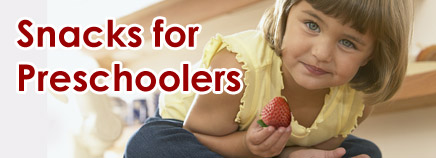
Filling Nutritional Gaps
No one’s busier than the average preschooler. Preschoolers are so active and imaginative, it’s no wonder they get hungry between meals and need a snack.
Although growth during the preschool years is slower compared with that of the first 2 years of life, preschool kids still need to eat a balanced diet that includes whole grains, lean meat, beans, low-fat milk, fruits, and vegetables.
That’s sometimes easier said than done. Some preschoolers don’t eat well at mealtime. Others might be willing to eat, but only certain foods. This can leave nutritional gaps in a child’s diet. Healthy and well-timed snacks can help fill in these gaps. They also can keep kids from getting overly hungry and cranky.
Tips for Smart Snacking
So how do you turn preschoolers into smart snackers?
- Keep healthy snacks in your refrigerator or pantry. Let kids choose their own snacks from among a couple of nutritious options.
- Offer a variety of snacks, not just the ones kids already likes. Offer new choices, but don’t give up on foods that may have been rejected in the past. It may take a few tries before a child accepts a new food.
- Have a schedule for meals and snacks. This lets kids manage their hunger because they know when to expect the next chance to eat at the next scheduled time. Avoid letting kids pick throughout the day, which can dull internal hunger cues and make them more likely to overeat.
- Don’t let kids eat in front of the TV. Serve snacks and meals at the table.
- Keep mostly healthy foods in the house, with those high in calories, fat, and added sugar kept to a minimum. This doesn’t mean kids can never have these foods, but they should be offered only once in a while.
- Serve skim or low-fat milk or water with snacks instead of sugary drinks and soda. Limit 100% juice to one serving per day.
- Make your preschooler a part of the action! Kids this age feel important when adults let them help out. Let them do what they safely can to prepare their own snacks — whether that’s tossing the fruit salad or putting utensils and napkins on the table.
- Keep an eye on how your child’s moods affect eating patterns. Preschoolers often confuse boredom or fatigue with hunger. If your child just ate and is complaining of hunger again, see if a change of scenery or some active play could do the trick.
- Share a healthy snack with your kids, who will follow your lead and get the message that you’re serving something good.
Be Creative
Preschoolers are anything but boring, so why should their snacks be? Being creative when it comes to expanding the snack menu doesn’t have to be complicated or time consuming.
Here are a few action-snack suggestions to get you started:
Cut it! Use a cookie cutter to cut cheese, veggies, and sandwiches into fun, irresistible shapes.
Dip it! Pair slices of fruit, veggies, or whole-wheat crackers with a side of dip. Whether it’s peanut butter, low-fat ranch dressing, guacamole, salsa, applesauce, or yogurt, everyone loves to dip.
Create it! Make art out of food. Try apple-wedge flower petals around a kiwi slice for some flower art. Or maybe fun food faces with berry eyes and a banana mouth.
Sip it! Who says you have to eat a healthy snack? Fruit smoothies made with low-fat yogurt or milk and fresh fruit are a great way for kids to drink up needed nutrients.
Crunch it! Low-fat granola and lower-sugar, whole-grain breakfast cereals are good choices. Also try toasted whole-wheat pita wedges for a satisfying crunch without the salt and fat of potato chips.
Play it! Turn healthy snacking into a game. For example, try making a “food rainbow” on a plate and let your child decide which colors to eat first. Next time, you can do the same with different shapes. Which will it be — squares or triangles?

